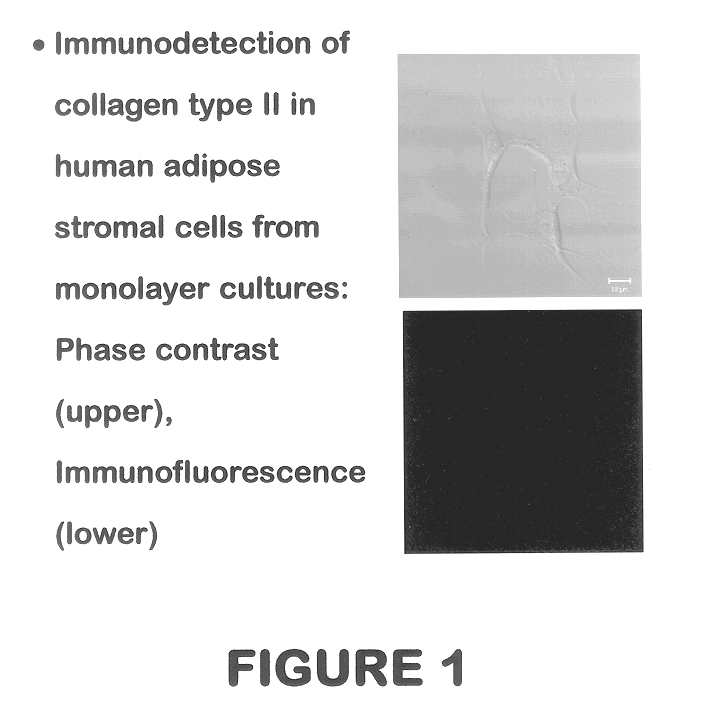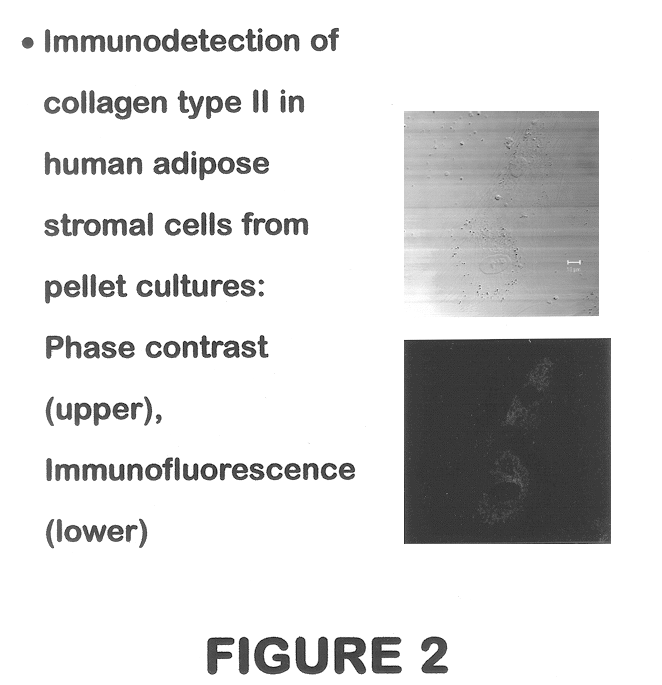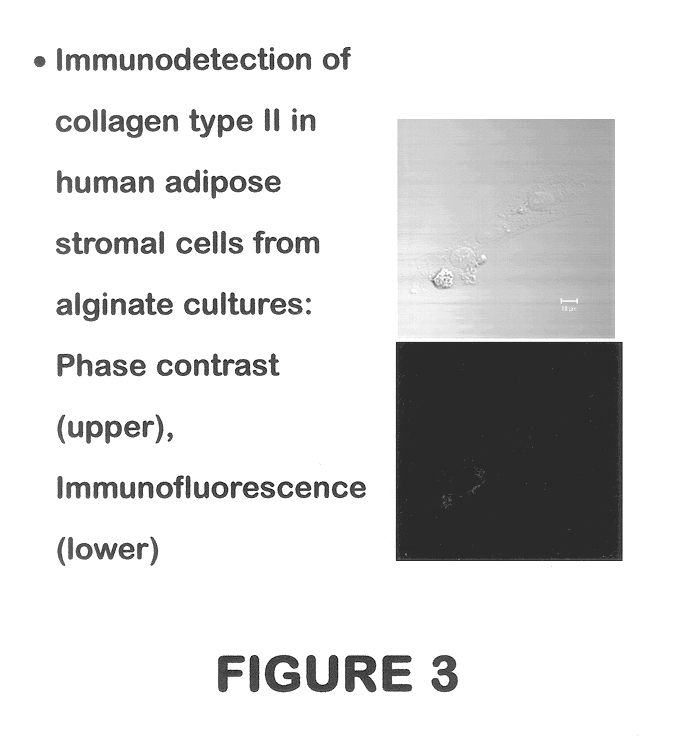Use of adipose tissue-derived stromal cells for chondrocyte differentiation and cartilage repair
a technology of chondrocyte differentiation and cartilage repair, which is applied in the direction of skeletal/connective tissue cells, prosthesis, drug composition, etc., can solve the problems of low yield of stem cells from this source, difficulty and risk of bone marrow biopsy procedures, and the use of these cells
- Summary
- Abstract
- Description
- Claims
- Application Information
AI Technical Summary
Benefits of technology
Problems solved by technology
Method used
Image
Examples
example 1
In vitro Chondrogenesis using Dexamethasone
Stromal cells are isolated from human subcutaneous adipose tissue according to methods described in "Methods and Composition of the Differentiation of Human Preadipocytes into Adipocytes" Ser. No. 09 / 240,029, filed Jan. 29, 1999, now U.S. Pat. No. 6,153,432. These cells are plated at a density of 500 to 20,000 cells per cm.sup.2. The present invention contemplates that the creation of a precartilage condensation in vitro promotes chondrogenesis in mesenchymal progenitor cells derived from human adipose tissue. This is accomplished by methods including, but not limited to:
(1) The pellet culture system, which was developed for use with isolated growth plate cells (Kato et al. (1988) PNAS 85:9552-9556; Ballock & Reddi, J. Cell Biol. (1994) 126(5):1311-1318) and has been used to maintain expression of the cartilage phenotype of chondrocytes placed in culture (Solursh (1991) J. Cell Biochem. 45:258-260).
(2) The alginate suspension method, where ...
example 2
Preparation of Synthetic Cartilage Patch
Following proliferation, the chondrogenic cells still having chondrogenic potential may be cultured in an anchorage-independent manner, i.e., in a well having a cell contacting, cell adhesive surface, in order to stimulate the secretion of cartilage-specific extracellular matrix components.
Heretofore, it has been observed that chondrogenic cells proliferatively expanded in an anchorage-dependent manner usually differentiate and lose their ability to secrete cartilage-specific type II collagen and sulfated proteoglycan. (Mayne et al. (1984) Exp. Cell. Res. 151(1): 171-82; Mayne et al. (1976) PNAS 73(5): 1674-8; Okayama et al. (1976) PNAS 73(9):3224-8; Pacifici et al. (1981) J. Biol Chem. 256(2): 1029-37; Pacifici et al. (1980) Cancer Res. 40(7): 2461-4; Pacifici et al. (1977) Cell 4:891-9; von der Mark et al. (1977) Nature 267(5611):531-2; West et al. (1979) Cell 17(3):491-501; Oegama et al. (1981)J. Biol. Chem. 256(2):1015-22; Benya et al. (19...
example 3
Surgical Repair of Articular cartilage Defect
Cartilage defects in mammals are readily identifiable visually during arthroscopic examination orduring open surgery of the joint. Cartilage defects may also be identified inferentially by using computer aided tomography (CAT scanning); X-ray examination, magnetic resonance imaging (MRI), analysis of synovial fluid or serum markers or by any other procedures known in the art. Treatment of the defects can be effected during an arthroscopic or open surgical procedure using the methods and compositions disclosed herein.
Accordingly, once the defect has been identified, the defect may be treated by the following steps of (1) surgically implanting at the pre-determined site, a piece of synthetic articular cartilage prepared by the methodologies described herein, and (2) permitting the synthetic articular cartilage to integrate into pre-determined site.
The synthetic cartilage patch optimally has a size and shape such that when the patch is impla...
PUM
| Property | Measurement | Unit |
|---|---|---|
| concentration | aaaaa | aaaaa |
| concentration | aaaaa | aaaaa |
| concentration | aaaaa | aaaaa |
Abstract
Description
Claims
Application Information
 Login to View More
Login to View More - R&D
- Intellectual Property
- Life Sciences
- Materials
- Tech Scout
- Unparalleled Data Quality
- Higher Quality Content
- 60% Fewer Hallucinations
Browse by: Latest US Patents, China's latest patents, Technical Efficacy Thesaurus, Application Domain, Technology Topic, Popular Technical Reports.
© 2025 PatSnap. All rights reserved.Legal|Privacy policy|Modern Slavery Act Transparency Statement|Sitemap|About US| Contact US: help@patsnap.com



